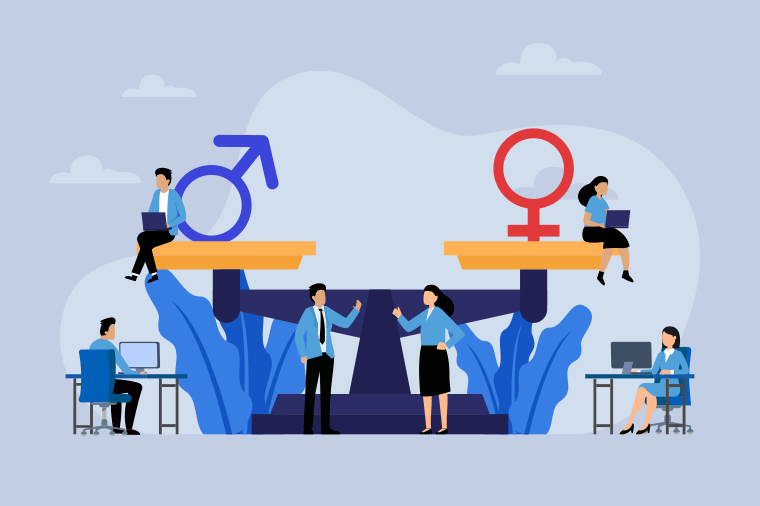Corporate Discussion on Obstacles to Growing More Gender-Inclusive Workplaces
The corporate commitment to gender-inclusive workplaces has intensified, marked by innovative strategies and profound challenges. This special report examines the strides being made in promoting gender equality in the workplace, backed by factual insights and recent examples of corporate initiatives.
Current State of Gender Inclusivity in Corporations
Increasing Female Leadership Representation
A 2021 McKinsey report reveals that women's representation in the C-suite has slowly increased, yet only 21% of C-suite executives are women. Companies like Salesforce and PepsiCo have made headlines by implementing targeted leadership programs aimed at closing this gap, which involve mentorship initiatives and bias-free recruitment processes to foster diversity in the workplace.
Adoption of Inclusive Policies
Many corporations have begun to rigorously enforce comprehensive inclusive policies. For example, Google has updated its internal policies to ensure equitable pay and comprehensive anti-discrimination measures, which has set a benchmark in the tech industry for others to follow, enhancing gender equality in the workplace.
Persistent Challenges
Cultural and Structural Barriers
Despite progress, deep-seated cultural norms continue to hinder gender-inclusive workplaces. The persistence of 'boys' club' cultures in industries like finance and tech subtly undermines efforts to foster inclusivity. Tackling these requires not just policies but a fundamental shift in corporate culture, a challenge highlighted in recent diversity reports from companies like Goldman Sachs and Amazon.
Support Systems Deficiency
The lack of adequate support for work-life balance remains a significant barrier. For instance, while Netflix has introduced up-to-one-year paid parental leave, many companies still lag behind, offering minimal maternity and no paternity leave, which can discourage equality at home and work, thereby affecting diversity in the workplace.
Effective Strategies for Enhancing Gender Inclusivity
Focused Education and Awareness Programs
Companies are increasingly turning to education to change workplace cultures. For example, Ernst & Young has launched an extensive diversity and inclusion training program, which has been mandatory for all new hires, focusing on dismantling subconscious biases and fostering a supportive work environment, essential for gender equality in the workplace.
Mentoring and Networking Opportunities
Creating mentoring programs that pair young female professionals with senior leaders has proven effective. Companies like Accenture have established women’s mentorship programs that not only offer guidance but also actively promote career advancement for women within the firm, contributing to gender-inclusive workplaces.
The Path Forward: Actionable Steps and Global Perspectives
Continuous Policy Evaluation
Effective gender inclusivity requires ongoing policy evaluation to adapt to new challenges and feedback. IBM regularly revises its diversity policies based on employee feedback gathered through bi-annual surveys, ensuring that their initiatives remain relevant and impactful, promoting gender equality in the workplace.
Diversity Celebrations
Celebrating diversity through corporate events and recognitions can significantly enhance workplace inclusivity. International Women's Day, for instance, is widely marked by companies like Zara and H&M with campaigns that not only celebrate women's achievements but also promote gender equality in workplace practices.
Leveraging Global Insights
The challenge of gender inclusivity is global. Collaborations and knowledge exchanges between multinational corporations can pave the way for innovative solutions. The partnership between UN Women and Unilever is an example of how global insights can lead to powerful advocacy and real change in corporate policies worldwide, enhancing gender-inclusive workplaces.
As the corporate world continues to grapple with the complexities of fostering gender-inclusive workplaces, the need for comprehensive strategies and tangible actions becomes more apparent. This extended discussion explores additional layers of strategies and global initiatives, shedding light on the path forward for corporations striving for gender equality in the workplace.
Expanding the Scope of Inclusive Practices
Innovative Recruitment Strategies
In the pursuit of gender inclusivity, recruitment practices play a pivotal role. Progressive companies are now utilizing AI and machine learning tools to remove biases from the recruitment process. For instance, LinkedIn has introduced algorithm adjustments that ensure job ads are equally visible to all genders, countering the trend where certain ads, especially in tech and engineering, traditionally skewed towards male users.
Transparent Progress Tracking
Transparency in tracking progress towards gender inclusivity not only holds companies accountable but also showcases real-time results of inclusivity efforts. Salesforce, a pioneer in this area, has publicly shared its diversity goals and annual outcomes for several years, encouraging a culture of accountability and continuous improvement, which is crucial for gender equality in the workplace.
Enhancing Legal Frameworks
Governments are also playing a crucial role by enhancing legal frameworks to support gender inclusivity. In countries like Sweden and New Zealand, legislation requiring companies to perform gender pay audits and report discrepancies has led to more proactive efforts to achieve pay equity, promoting diversity in the workplace.
Addressing Workplace Culture Directly
Redefining Workplace Culture for Women
Creating an environment that truly values diversity and inclusion goes beyond policies and training. Companies like Patagonia have taken bold steps by restructuring their work environments to be more family-friendly, including offering on-site childcare and flexible working hours that appeal to all parents, irrespective of gender, fostering gender-inclusive workplaces.
Encouraging Male Participation
To achieve real gender inclusivity, male employees must also be engaged in the process. Initiatives like HeForShe, started by UN Women, have been instrumental in encouraging men to participate actively in discussions and actions that promote gender equality in the workplace.
Long-Term Commitments and Industry Collaboration
Sustained Commitments
Long-term commitment from top management is essential for the success of gender inclusivity initiatives. Companies like IBM have demonstrated this by maintaining diversity and inclusion programs for decades, constantly evolving them to meet new challenges and societal expectations, essential for fostering gender-inclusive workplaces.
Industry-Wide Collaboration
Collaboration across industries can amplify the impact of gender inclusivity efforts. The EDGE Certification, which measures and certifies businesses on gender equality, is one example where companies from various sectors come together to set common standards and share best practices, promoting diversity in the workplace.
Leveraging Technology and Innovation
Using Technology for Inclusivity
Technology is not just a tool for business operations but also a catalyst for promoting inclusivity. Innovative tech companies are developing software that helps identify and eliminate bias in performance evaluations and management decisions, ensuring fair treatment for all employees, enhancing gender equality in the workplace.
Virtual Reality Training
Emerging technologies like virtual reality (VR) are being used for immersive diversity training programs. These programs place employees in scenarios where they might face discrimination, helping to increase empathy and understanding across the workforce, which is essential for gender-inclusive workplaces.
Global Perspectives and Cultural Sensitivity
Adapting to Cultural Variations
The global nature of many corporations requires a nuanced approach to gender inclusivity that respects cultural variations. Multinational companies are creating region-specific strategies that address local cultural norms and legal requirements while upholding a global standard for gender equality, fostering gender-inclusive workplaces.
Shared Global Initiatives
Global initiatives like the Women's Empowerment Principles, a partnership between UN Women and the UN Global Compact, provide a framework for businesses worldwide to align their strategies with international standards on promoting gender equality, enhancing diversity in the workplace.
In conclusion, the journey towards gender-inclusive workplaces is complex and multifaceted. It requires a combination of innovative strategies, long-term commitments, and global cooperation. By embracing these principles, companies can not only enhance their work environments but also contribute to broader societal change, paving the way for true gender equality in the corporate world and beyond.




